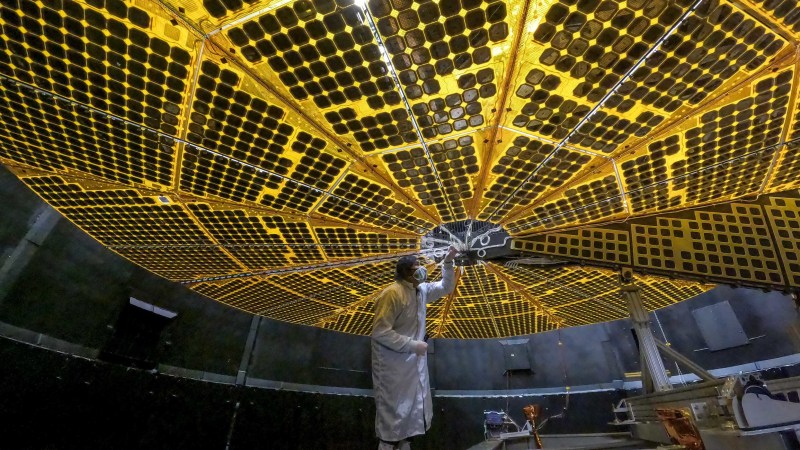The good news about using solar power to explore space is there are no clouds to block your sunlight. Some dust and debris, yes, but nowhere near what we have to deal with on planets. The bad news is, as you wander further and further out in the solar system, your panels capture less and less of the sunlight you need for power. NASA’s Lucy spacecraft will be dependent on every square inch, so we’re happy to hear technicians have successfully tested its solar panel deployment in preparation for an October 2021 launch.

Lucy’s 12-year mission is to examine one Main Belt asteroid and seven so-called Trojans, which are asteroids shepherded around the Sun in two clusters at Lagrange points just ahead and behind Jupiter in its orbit. The convoluted orbital path required for all those visits will sling the spacecraft farther from the sun than any solar-powered space mission has gone before. To make up for the subsequent loss of watts per area, the designers have done their best to maximize the area. Though the panels fold up to a package only 4 inches (10 centimeters) thick, they open up to an enormous diameter of almost 24 feet (7.3 meters); which is enough to provide the roughly 500 watts required at literally astronomical distances from their power source.
Near-Earth asteroids are exciting targets for exploration partly because of the hazards they pose to our planet. Trojan asteroids, thought to be primordial remnants of the same material that formed the outer planets, pose no such danger to us but may hold insights about the early formation of our solar system. We’re already eagerly anticipating the return of OSIRIS-REx’s sample, and Hayabusa2 continues its mission after so many firsts. An extended tour of these farther-off objects will keep us watching for years to come. Check out the video embedded below for Lucy’s mission overview.
















Surely this is once instance where smaller would be better. Being a 7.3 meters (24 feet) target for debris has to be an undesirable feature. Or would going nuclear with a 500+ watt Radioisotope Thermoelectric Generator be an even bigger gravitational target because it would be actively attracting debris towards it ?
Assuming they have designed the panel correctly it will be able to take some damage and still function, and its not like they intend debris collisions. Which wouldn’t be good for a nuclear powered device either… And big as 24 feet sounds its still peanuts compared to space.
I suspect the main reason they are using solar this time is it sounds like its going to be a rather high power draw and long lived probe, with lots of course corrections. So the size and weight of the nuclear version required to ensure high enough power output out towards the end of its life is probably counter productive. Could be any number of other reasons though, I don’t know enough about this mission to make more than a guess.
I’m pretty sure there has been a bit of a plutonium shortage at NASA. Perhaps they didn’t want to spend it all in one place?
There was an American launch of a probe a good number of years back that suffered a serious lot of public outcry as it was powered by a Plutonium RTG that could become a widespread disaster if there were an incident at launch. Attention in the US was widespread in the news for weeks. It was still launched, no glitches, but I doubt NASA, ESA, or others will be eager to provoke a repeat of such a large public outcry.